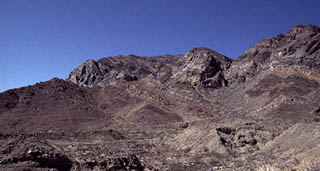- We did and corrected workbook pages 58-62.
What was collected?
- Section 6-4 Review worksheet.
What was assigned?
- Bring textbook on Friday.
Daily Science Fact

The Marble Mountains are a rather small mountain range located in one of the harshest, driest parts of the Mojave Desert, in southeastern California near the tiny towns of Chambless and Cadiz. What makes the Marble Mountains especially attractive to paleontologists is the comparatively rich Cambrian fossil biota which can be found in a particular rock layer, the Latham Shale, that is well-exposed in the southern part of the range, as well as in some nearby ranges such as the Bristol Mountains. The Latham Shale and the rock layers below and above it comprise a well-studied section of Lower and Middle Cambrian strata, which extends, with some variation, over a large part of the southern Mojave Desert.